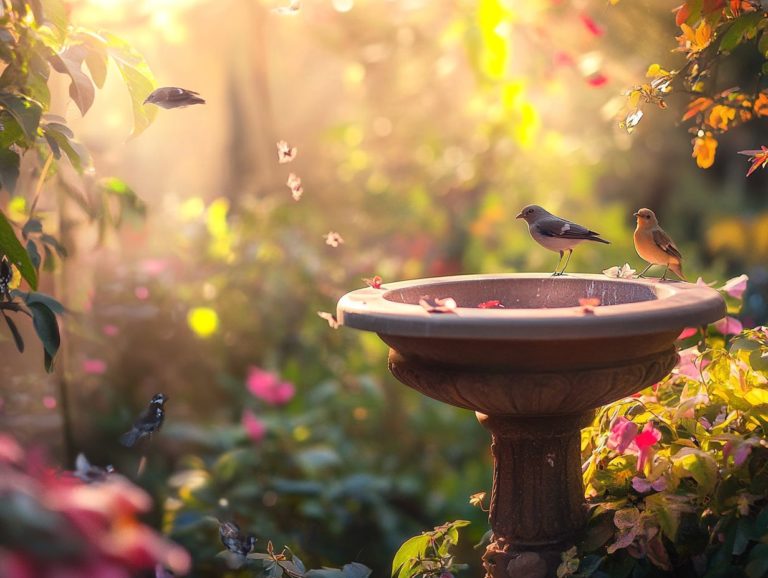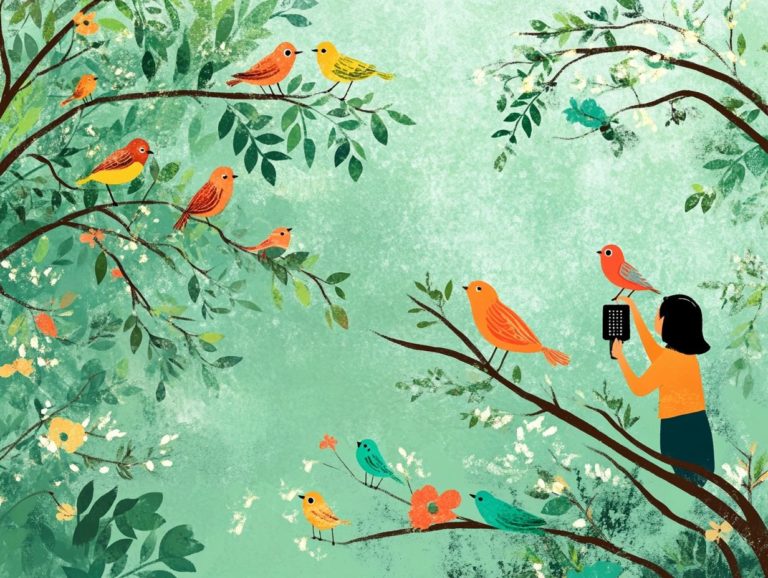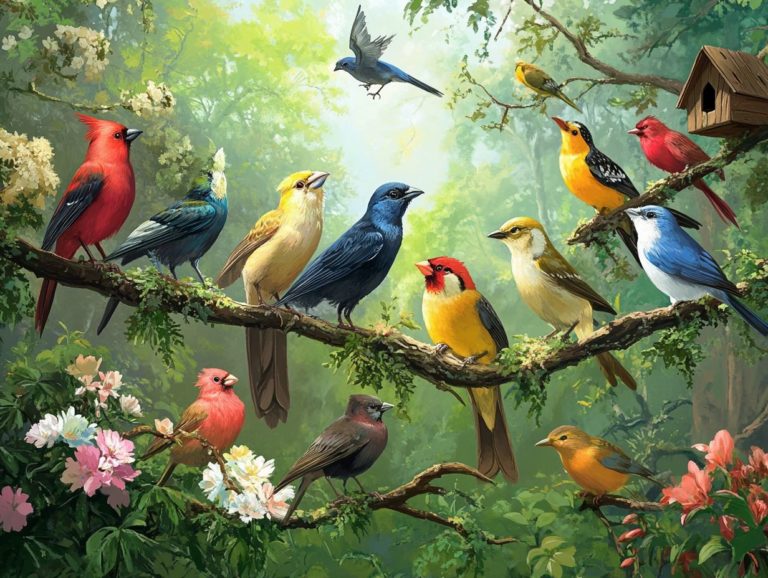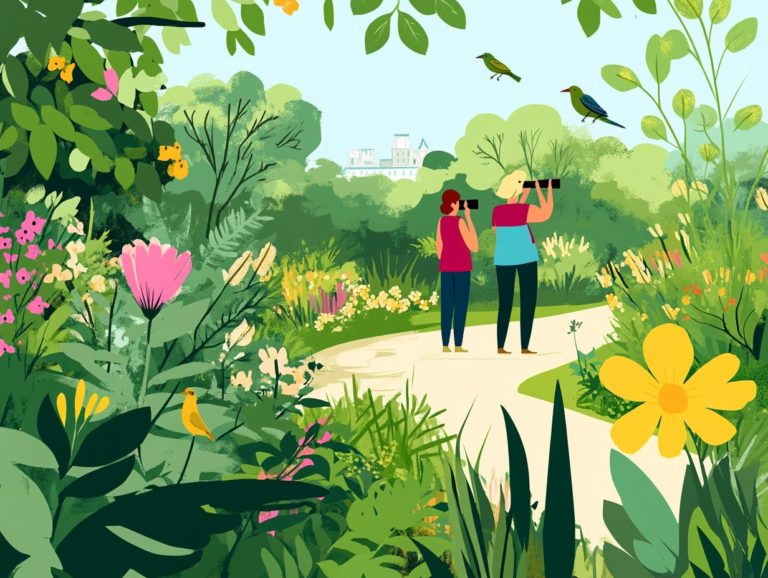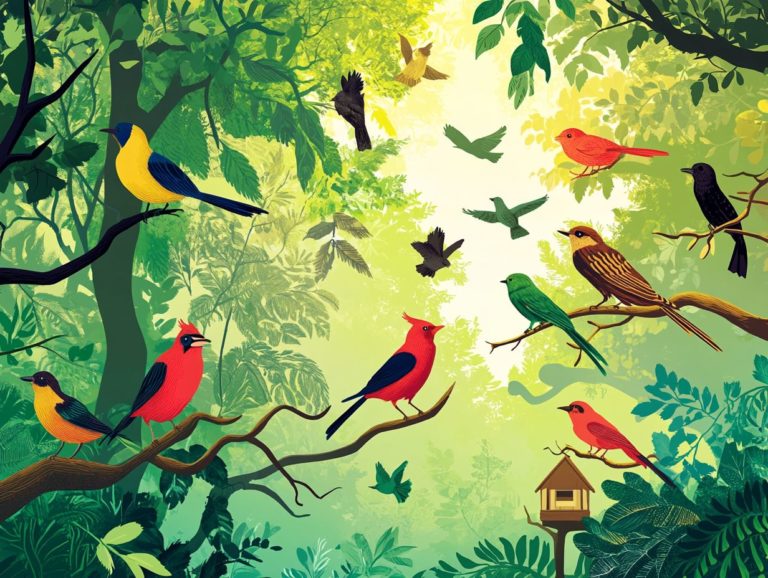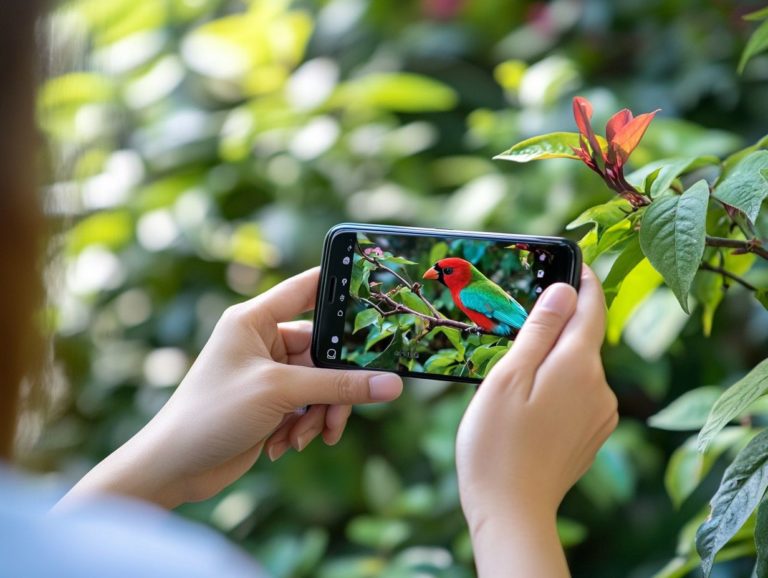How to Start Bird Watching as a Hobby?
Bird watching is more than just a hobby; it serves as a gateway to nature, brimming with benefits for both your physical and mental well-being.
This guide will help you dive right into bird watching, covering everything from necessary equipment and identifying common species to discovering the best local spots and travel destinations.
Whether you re just starting out or seeking to elevate your skills, the tips and guidelines provided will guarantee a fulfilling and enjoyable birding experience.
Dive into the wonders of bird watching and forge a deeper connection with the beauty of the natural world!
Contents
- Key Takeaways:
- Benefits of Bird Watching as a Hobby
- Getting Started with Birdwatching
- Best Places for Birdwatching
- Tips for Successful Bird Watching
- Frequently Asked Questions
- 1. What is bird watching and why should I consider it as a hobby?
- 2. What equipment do I need to start bird watching?
- 3. How can I find good bird watching spots near me?
- 4. Can I start bird watching even if I don’t know much about birds?
- 5. How can I attract birds to my backyard?
- 6. Is there a specific time of day for bird watching?
Key Takeaways:

- Bird watching is an enjoyable and beneficial hobby that promotes physical and mental well-being.
- Essential equipment, proper techniques for identifying and spotting birds, and knowledge of local and travel destinations can help beginners start bird watching successfully.
- Respect for birds and their habitats, as well as safety guidelines, are crucial for a successful and ethical bird-watching experience.
What is Bird Watching?
Bird watching, or birding as it s often called, is an enthralling outdoor pursuit that invites you to observe and identify various bird species in their natural environments. Whether you re wandering through parks, exploring wildlife refuges, or simply enjoying your backyard, this activity can be wonderfully enriched by tools like binoculars and field guides think the Audubon Bird Guide or the Kaufman Field Guide.
This engaging pastime nurtures a deeper appreciation for wildlife and enhances your ability to notice details, allowing you to connect with a vibrant community of fellow bird enthusiasts.
The charm of bird watching lies not only in the excitement of spotting elusive species but also in the peaceful respite it provides from the daily grind, transforming your experience into a meditative escape. You might find yourself joining birdwatching clubs, where you can exchange tips and resources, attend enlightening workshops, and embark on organized outings, all while building friendship with others who love bird watching.
Utilizing bird identification resources such as apps and online databases can elevate your experience, making it simpler to recognize the unique calls and markings of different birds. Engaging in this pursuit fosters a sense of awareness of our environment and conservation, inspiring you to cherish and protect natural habitats for generations to come.
Benefits of Bird Watching as a Hobby
Bird watching presents a wealth of benefits that go far beyond simple enjoyment. As a hobby, it significantly enhances both your physical and mental well-being while deepening your connection to nature and championing conservation efforts.
By immersing yourself in this outdoor activity, you sharpen your observation skills and discover a unique perspective on diverse habitats. You also join a lively birding community that shares your passion for wildlife observation, enriching your experience even further.
Physical and Mental Health Benefits
Participating in birdwatching isn t just a fulfilling hobby; it offers substantial physical and mental health benefits. Engaging in this activity encourages you to embrace the outdoors and dive into nature exploration. Observing birds in their natural habitats serves as a fantastic stress reliever, enhancing your overall well-being while sharpening your ability to notice details necessary for identifying various bird species.
You ll often hike and walk while enjoying this pursuit, allowing you to partake in moderate cardiovascular exercises that bolster your physical fitness. As you traverse different landscapes, the natural rhythm of movement combined with the thrill of discovery fosters both strength and stamina. Meanwhile, the tranquil environment works wonders for your mental clarity, helping you to reduce anxiety and enhance your focus.
Simply observing birds can lift your spirits, connecting you to the beauty of nature and promoting mindfulness. In essence, this rewarding activity nurtures both your body and mind, cultivating skills that thrive through outdoor engagement.
Start your bird-watching journey today and connect with nature like never before!
Getting Started with Birdwatching
Starting your journey into birdwatching is an exhilarating endeavor that requires minimal investment. All you need for success are some essential birding tools, particularly a good pair of binoculars and a dependable birding guide. To get started, check out what is bird watching and how to start.
With a bit of preparation and a few insightful tips, you can easily dive into backyard birdwatching or explore local parks by learning how to teach kids about bird watching, discovering and identifying a variety of bird species along the way.
Essential Equipment and Supplies
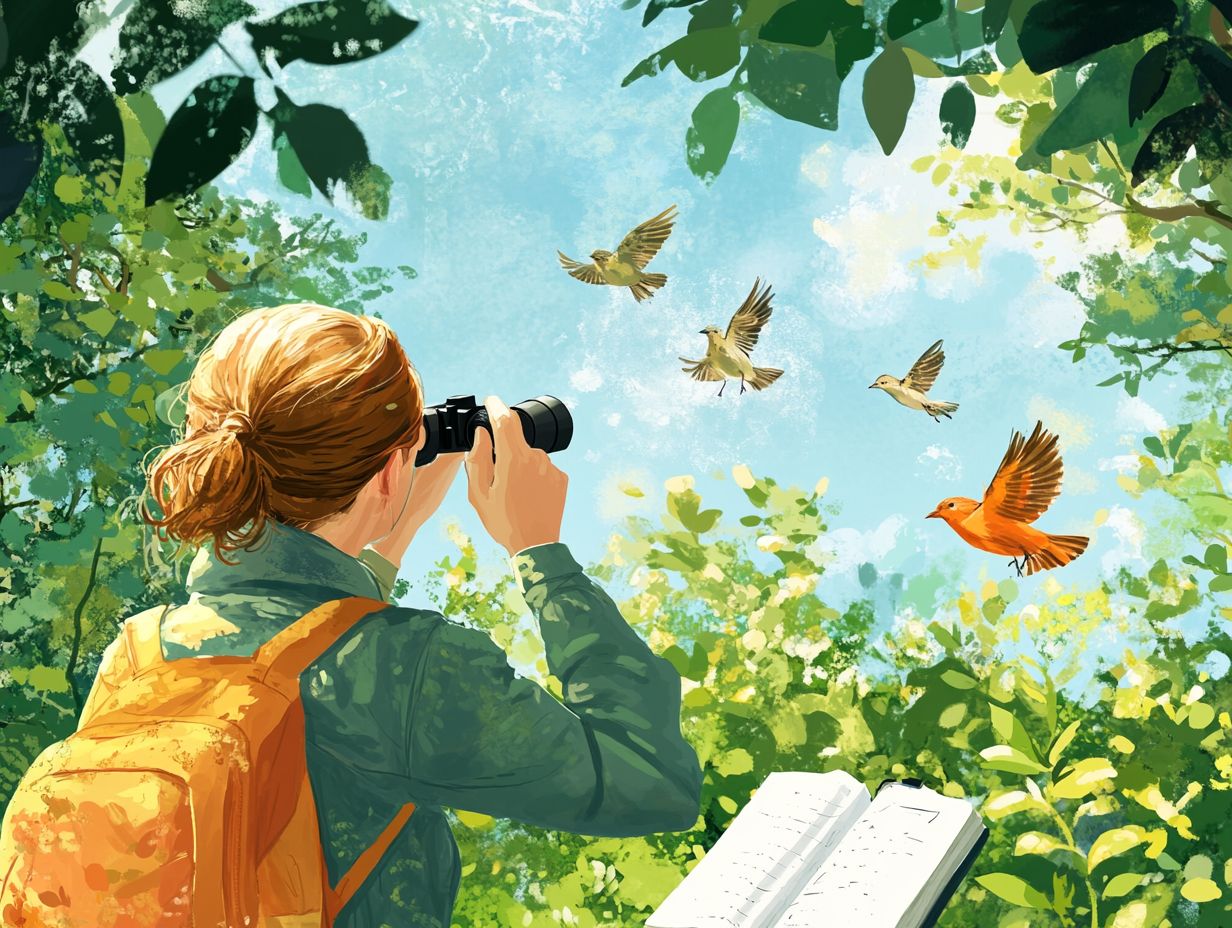
To enjoy a rewarding birding journey, having the right equipment is essential. You ll want top-quality supplies, including binoculars designed for birding, a reliable camera for stunning wildlife photography, and bird identification books or apps like the Audubon Bird Guide App to help you recognize the different species you encounter.
Quality binoculars with a magnification of at least 8×42 significantly enhance your viewing experience, letting you spot intricate details from a distance. A durable camera with a fast autofocus system helps capture those fleeting moments, especially in dynamic scenes in the wild.
Field guides, whether print or digital, provide essential information on bird calls, plumage variations, and habitat preferences. These tools enrich your birding experience and foster a deep connection with nature, encouraging a lifelong passion for this fulfilling hobby.
Identifying Common Birds
Identifying common birds is vital to your birdwatching journey. Honing your observation skills will significantly enhance your ability to recognize local avian species, including their unique behaviors, colors, and calls. Using birdwatching books and apps, you can become familiar with the diverse species in your area, enriching your overall wildlife observation experience.
Getting close to the natural habitats where birds thrive gives you invaluable insights. Listening to bird calls acts as an auditory guide, helping you distinguish between species, especially when they re hidden from view. Observing behaviors like feeding habits or courtship displays provides crucial clues to a bird s identity.
Joining local birdwatching communities or workshops can refine your skills. Sharing experiences with others fosters a deeper understanding of avian life, transforming you from a casual observer into a knowledgeable bird enthusiast.
Best Places for Birdwatching
Exploring the finest locales for birdwatching can significantly enhance your experience. Whether you visit local parks, wildlife refuges, or embark on journeys to celebrated birding hotspots across the country, each destination offers diverse bird species and unique habitats.
These exceptional sites provide unparalleled opportunities for observation, allowing you to witness the exquisite beauty of various birds in their natural environments.
Grab your binoculars and head out to explore!
Local Parks and Wildlife Refuges
Local parks and wildlife refuges are great places for your birdwatching adventures. They offer a rich tapestry of habitats that attract many different bird species. This makes it easy for you to dive into nature exploration and wildlife observation right in your community.
These locations provide resources such as detailed maps and guided tours to elevate your experience.
Take, for example, the coastal wetlands at the local wildlife refuge. You can witness a breathtaking array of waterfowl, including majestic herons and vibrant ducks, especially during migration seasons, when birds move to different areas for breeding or feeding. Just a stone’s throw away, the expansive meadows of the regional park teem with lively songbirds and soaring hawks, captivating both novice and seasoned birdwatchers alike.
Community members frequently gather for organized birding events. This fosters a sense of stewardship for local wildlife while encouraging deeper connections to nature. With habitats ranging from lush woodlands to serene marshes, these unique locales are brimming with opportunities for you to learn about the diverse bird life that calls these areas home.
Travel Destinations for Bird Watching
For avid birdwatchers like you, the world is a treasure trove of unforgettable experiences. Travel destinations offer exceptional birding opportunities. From lush tropical rainforests to serene remote wetlands, each locale presents a stunning array of bird species just waiting to be discovered. These sought-after birding hotspots draw enthusiasts from every corner of the globe, providing rich environments perfect for observation and photography.
Take Costa Rica, for instance. This paradise is renowned for its diverse ecosystems, including enchanting cloud forests and picturesque coastal mangroves. Here, don t miss the chance to see the resplendent quetzal or the endangered scarlet macaw.
Then there are the wetlands of the Florida Everglades. This is a hotspot for spotting the elusive roseate spoonbill and the majestic bald eagle.
For those eager to witness unique avian behaviors in their natural habitat, the Gal pagos Islands offer an unparalleled experience. You ll find endemic species like the blue-footed booby, while knowing that conservation efforts are actively working to preserve these fragile environments.
Tips for Successful Bird Watching
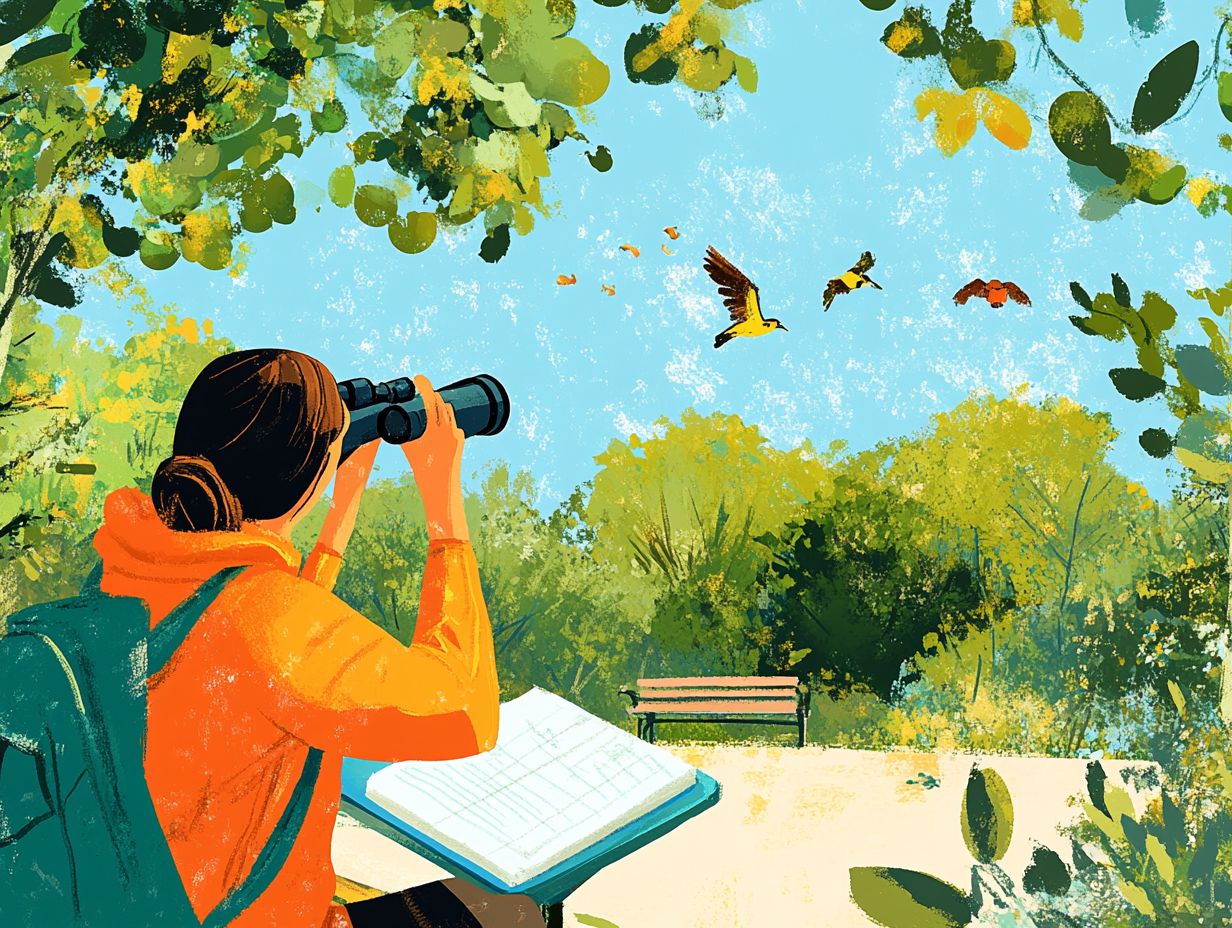
To elevate your birdwatching experience, it’s essential to employ effective techniques for spotting and identifying birds. Additionally, adhere to safety guidelines and proper etiquette during your observations.
By grasping these vital components, you can enrich your enjoyment of this fulfilling hobby and minimize disturbances to the birds and their habitats.
Techniques for Spotting and Identifying Birds
Employing effective techniques for spotting and identifying birds is essential for enhancing your birdwatching experience. It boosts your observational skills and increases your chances of recognizing various species in their natural habitats.
By sharpening your attention to detail and familiarizing yourself with common bird calls, you can cultivate a deeper connection to the environment around you. Techniques such as observing specific behaviors, noting flight patterns, and understanding seasonal migrations will significantly enrich your experience.
Investing time in high-quality field guides or reliable mobile apps can equip you with valuable insights about the habitats, feeding habits, and vocalizations of different species. By blending these strategies, you can transform casual birdwatching into a more rewarding pursuit, fostering both appreciation and knowledge of the fascinating avian world.
Etiquette and Safety Guidelines
Get ready for an exciting birdwatching adventure! Maintaining proper etiquette and following safety guidelines is crucial.
This helps protect wildlife and their habitats while enhancing the experience for both birdwatchers and the surrounding community.
Practice responsible behavior by keeping a respectful distance from nests and sensitive areas. Use binoculars to enjoy the view without disturbing the birds.
Stick to designated trails to avoid damaging native plants. Engage with fellow birders to share conservation tips and strengthen community bonds.
Joining local conservation initiatives enriches your birdwatching experience. It helps us all commit to preserving bird species and their environments.
Frequently Asked Questions
1. What is bird watching and why should I consider it as a hobby?
Bird watching, or birding, involves observing and identifying birds in their natural habitats. This enjoyable hobby helps you connect with nature and promotes environmental awareness.
2. What equipment do I need to start bird watching?
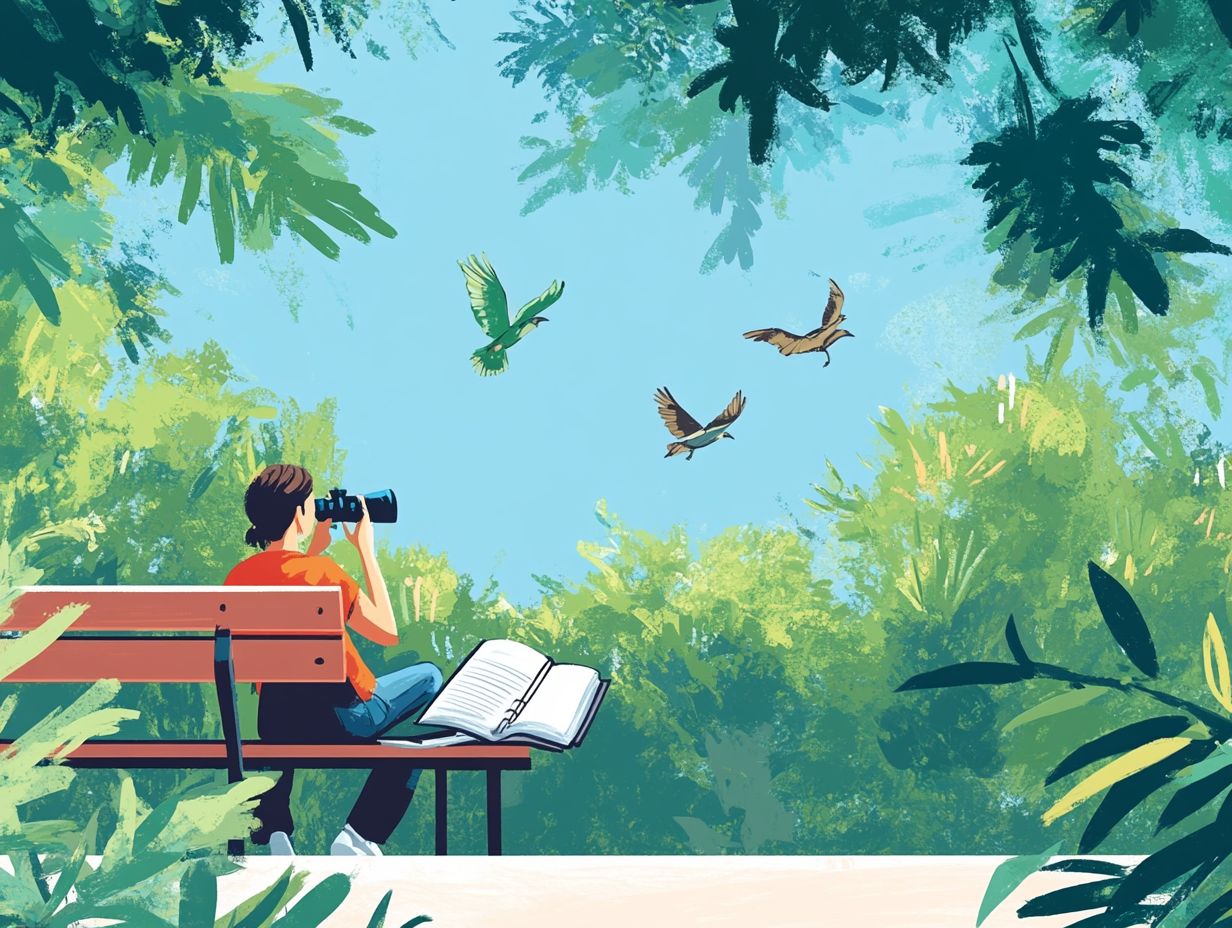
Essential equipment includes a good pair of binoculars, a field guide for identifying birds, and a notebook for recording your observations.
3. How can I find good bird watching spots near me?
Look for local birding clubs, online forums, or apps that list birding hotspots. Parks, nature reserves, and wildlife sanctuaries are great places to explore.
4. Can I start bird watching even if I don’t know much about birds?
Yes! Anyone interested in birds can start bird watching. To enhance your experience, consider following best practices for bird watching, using a field guidebook to learn about common birds, or joining birding groups for hands-on experience.
5. How can I attract birds to my backyard?
Attract birds by providing food sources like feeders, bird baths, and native plants that produce seeds and fruits. Create a safe environment to shelter them from predators.
6. Is there a specific time of day for bird watching?
Birds are most active early in the morning and late afternoon. Research the feeding and nesting habits of specific birds for the best viewing times.

